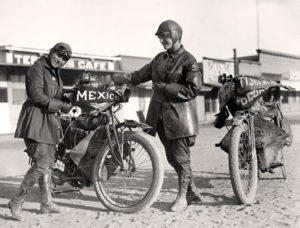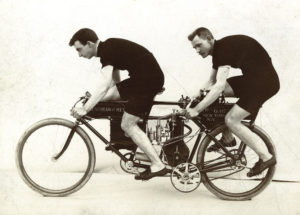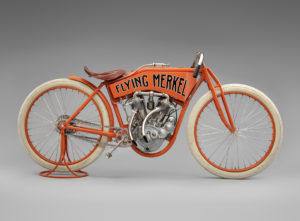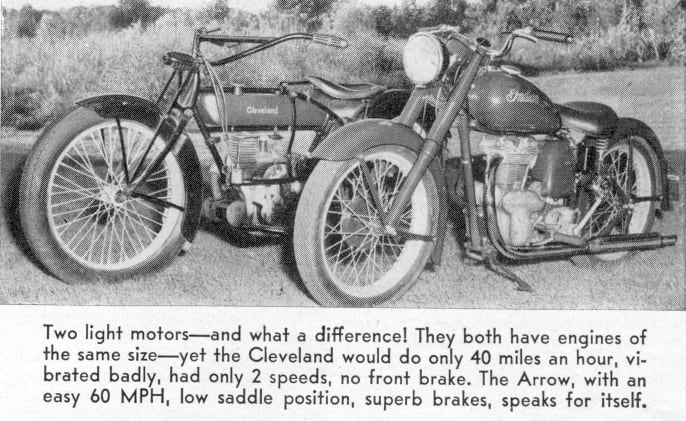Max does the ton thirty five
Records are made to be broken, especially in motorsports. Every season,
people try to shave lap times, horsepower figures and absolute speed records.
Most folks are happy to establish a new record, even if it is broken soon
thereafter. But to hold a record for over 52 years is simply amazing.
In the summer of 1948, Max Bubeck established what is still the highest
speed for an unstreamlined, normally-aspirated 80 cubic-inch, side-valve
(Indian) motor–135.58 mph. Max achieved this with his “Chout,” the
large Chief engine wedged in the smaller Scout frame. Think of an Evolution
motor stuffed into a 883 Sportster frame. What follows is an interview with
‘Mad Max.’
Minnesota Motorcycle Monthly: How did you get involved with speed trials?
Max Bubeck: I got out of high school in ’34 and I shagged in downtown
L.A.–pick-up and delivery.
M.M.M.: On a bike?
M.B.: On my 1930 Indian Four.
M.M.M.: So it’s something you did for fun?M.B.: Yes, and enduros. I rode about a total of 300 enduros altogether.
M.M.M.: Were you trained as a machinist or metallurgist?
M.B.: No, sorta’ a natural mechanic. I started out workin’ on my own stuff,
right away. Mainly because I was interested in it. I’m the kind of guy that can
figure out what’s wrong with things, and fix it. There was a lot of things I
couldn’t do, but after the war, when (fellow enduro rider) Frank Chase and I
started up the saw sharpening business, and I knew nothing about it–Frank had
worked at it, all during the war. We didn’t have that much business, and I was
no good at sharpening saws. Next door, Rollie Harper had a motorcycle shop
there, just a general motorcycle shop that did everything. He had his own
mechanics, but they’d have slopover, and he’d give me engines to work on. We’d
been hoppin’ up Chiefs for quite a while. Started back in the late 30s already.
By 1940, when Frank Christian arrived on the scene from back East, he came up
with the idea of the stroker Chief.
Indian finally made some good flywheels; ‘Z-metal’ they called ’em.
Meanite, which was a cast steel, instead of cast iron. Cast iron flywheels had
a tendency to explode (waves hands in a blast pattern) cast iron being very
brittle. (chuckles). When Christian came out with that idea, we immediately
went to strokers. I had been fooling around with porting; you know, working on
the heads and the top end and stuff, and Frank Chase would setup the lower
(end.)
As I say, I was kinda’ the do-nothing around there; I had to do
something, and so I started working on the motorcycle engines. We started
building stroker Chief engines for people. Pop Shunk was grinding the cams for
us. Fred Shunk, they called him ‘Pop.’ Where he got the name, I don’t know…
M.M.M.: What kind of prep work would you do?
M.B.: (starts sketching) Its attention to detail. Example: we were running
5/8″ spark lead, which means, when the piston’s 5/8″ from the top, it
would fire. I got to thinkin’ about this and finally, with the heads off and
setting up the timing, settin’ the mag (magneto) up; you’d set the front one at
5/8ths, and the rear one would be a half or 3/4. So what’s wrong? The cam on
the mag. You take the one that’s firing too soon, and you carefully, with a
little Dremel grinder, go in there and grind the lead off of that breaker cam.
Now you get both of them firing (in) the same place.
M.M.M.: Did you ever experiment with shorter stroke/big bore, like everyone
does today?
M.B.: You can’t on an Indian. When we got to 30 over, we’d throw ’em (the
cylinders) away. If we didn’t, we’d blow ’em off–the cylinders are that thin
at the bottom. Harley’s always been big. You can bore ’em, you can stroke ’em,
do all kinds of things to them. But the Indian was always skimpy on cylinder
wall size. Anyway, this was all seat of the pants stuff. I came up with this
stuff on my own, and apparently it worked. There were always a lot of people
that were building things that were gonna go quicker than we were, but they
never did. And they haven’t yet today. (chuckles)
M.M.M.: Let’s talk about your porting. Was that strictly trial and error?
M.B.: We had no flow benches, no dynos, no nothin.’ When Indian came out
with the Bonneville Chiefs and Scouts in 1938…
M.M.M.: That was a cam and what else?
M.B.: They had a factory cam in ’em too, but (Pop) Shunk was a far better
cam grinder than that. You see, there is nothing that the factory does that
somebody can’t improve on. Even today.
M.M.M.: What about 4-valve heads vs. 2-valve heads?
M.B.: Well, that’s more breathing. I looked at the way Indian was setting
up their Bonnevilles, and the way they shaped their intake ports, and then I
went ahead on some other things. On the Chout, when we first built that stroker
thing, even in a Chief frame it ran 128 1/2 mph. Somehow, that seemed to be the
barrier, you’d never get past that. (laughter) (It’d) go between 125-128 mph
every time we went to speed trials. I just desperately wanted to go 130 mph, so
we geared for 130 mph. We had it on Frank Christian’s dyno, and we were puttin’
out 65 horsepower at 44 hundred R’s – This with two carbs, one for each intake
port.
M.M.M.: On the crank, or on the rear wheel?
M.B.: Rear wheel. We figured out the sprockets we wanted. We had a 30
(tooth) on front, and a 36 on the rear and then the ratio between the primary
made the difference. 2.60:1 gear ratio, anyway. When I finally ran 135 1/2, it
was turning 4600, which was over the horsepower. So if it’d had some more gear,
and we didn’t have any more available, well, we coulda’ run faster. Hindsight
is great. After that, well that’s the last time we ever ran, we put the thing
in a, Pop Shunk had an old board track frame, and we put it in that. (We)
didn’t bother puttin’ braces on the cylinders, and blew a cylinder off on the
dyno. Then I says, ‘Hey we’re in the saw-sharpening business. We gotta get
outta foolin’ with motorcycles.’ We shoulda’ gone the other way (more laughter)
but we didn’t, so we practically quit then, you know.
M.M.M.: Does that make you feel good, or is it just-?
M.B.: Yeah it makes me feel good! When I realize what we did with what we
had, I mean we had no flow benches, we had a dyno when we finally finished up,
but that’s just end result. We didn’t keep goin’ to the dyno, we didn’t have
time, or the funds to do that. We just did (what we could with) what we had,
and it seemed to work.
M.M.M.: Did you ever play with valve size or springs?
M.B.: Oh we used Bonneville springs, which were double. Exhaust valve,
you leave alone. Intake valve, was flat (sketches valves) and tulip-shaped
here. I’d put ’em on a big 10″ grinding wheel, mostly to lighten (the)
valves.
M.M.M.: Tell me about your early hydraulic forks.
M.B.: The last job I had before I decided I’d better get into something
other than riding the damn motorcycle around the city all the time, I was
shagging for Economy Blueprint, out in North Hollywood. One of the stops that
we had was at Bendix. Bendix had an engineering building along a dirt road,
Empire, which at that time was not paved, and full of potholes and everything.
Usually, those engineers would be out there waiting for these prints. They were
always in a hurry for them, you know. You know, Indians had a leaf spring on
the thing and rigid rear and everything, And the guy says, ‘My God, those
things do a lot of bouncin’.’ and he let it go at that.
The next time I took something out there he said, “Would you be able
to let us use that machine for a couple of days and take some measurements?
We’re thinking about building some hydraulic forks for the front end.”
Bendix was making aircraft landing gears at the time, you know. Anyway, I
arranged to borrow somebody else’s machine and they had it for a couple of
days, and I got it back. Believe it or not, this was in August, 1939. Every
time I’d see the guy (Bendix Engineer) he’d say, ‘”Yeah, we’re getting
along well. We should have those forks in a couple of months.” Get all the
drawings done, and everything.
Early September, ’39, of course the war broke out in Europe, and they
didn’t have to worry about what the hell to do anymore (chuckles). Immediately
the US started building airplanes by the thousands, and Bendix was very busy
with their landing gears. That killed my Bendix fork arrangement for the
Four–but that’s how close I came to probably having the first American machine
with hydraulic forks on it.
M.M.M.: Tell me about the Vard story.
M.B.: In 1946, I’d put on Vard forks, and Vard was an outfit in Pasadena
that made drafting equipment. They made these things that draftsmen use that
got all these mickey-mouse arms on them. During the war, they used their
facilities for all kinds of different things, and they happened to have four
Pasadena Motorcycle Club members working there. Of course, in their spare time,
they were always comin’ up with something new, and when the war was over, they
already had thought a lot about some of this stuff, so they built these forks,
which were the forerunner of the Harley Hydra-Glide forks. Vard made these
forks extra-wide Because Harley front ends were a lot wider than Indian front
ends. They were made so they’d fit Harley or Indian, either one. Anyway, (Ed)
Kretz got the wholesale price, $50.00, which was what he charged me.
M.M.M.: How, did he have an in with-?
M.B.:
Oh, he was a dealer. They were pretty basic, and they worked well, but they
wore out pretty fast because they didn’t have any seals in ’em. They’d pump oil
out pretty rapidly, and then the oil would mix with the dust and the dirt and
help grind the (slider) bushing. The legs were not hard-chromed either, they
were just plain steel. They had no protection from wear, so the first thing I
did when I rebuilt my Four, I took the legs out and had ’em hard chromed. I
then made a bushing to fit that, and then I put a seal on the top of the
bushing. I’m still running the thing since 1986. I haven’t put any oil in ’em
or anything else, and they still work very well. Anyway, back to the forks.
Amazingly enough, Ed Kretz and I were good friends, they retailed for $72.00.
M.M.M.: So that would be a couple months pay?
M.B.: (softly) Well, no. Shagging I was making 25 bucks a week.
M.M.M.: So, three weeks pay?
M.B.: Yeah, still a lot of money.
Not content to rest, Max is building “Chout II.” Custom
fabricated with modern aluminum, imported Australian cylinders and heads
modified by Max. While the motor takes shape in Southern California, work
progresses on an authentic 101 Scout frame. It will be straightened, and extra
lugs removed–any and all excess weight removed. Cycle parts will be minimal.
Smaller Junior Scout gas and oil tanks, no fenders, aluminum rims. Anything to
reduce mass, aid airflow and help optimize Chout II’s potential top speed, and
break his own record.
M.M.M.: How do feel about your chances with Chout II?
M.B.: I’m pretty sure we can run at least 145 mph, maybe quicker. ‘Cause
now we know what to do about gearing.
M.M.M.: You gonna run her at El Mirage?
M.B.: I hate El Mirage! I’ve only ever gotten into two speed wobbles,
period. And both times were at El Mirage.
M.M.M.: Because of the wind? or..
M.B.: No, the surface. Both times, it shook my feet off the pegs, and I was
just hangin’ by the handlebars. (picture the photo of Rollie Free on the
Vincent) Somehow, it managed to straighten itself out. One time, the worst one
was at about, a little over 125 mph. I hit a big hole there, and it just shook
the hell out of things, and all of a sudden, straightened out again. (When) I
got back in, and we got to lookin’, we had this 19 inch, it was like a Triumph
wheel or something in there–no front brake or anything–just what we called a
spool hub.
M.M.M.: Sure. Like on a chopper.
M.B.: Yeah. Anyway, there were four spokes broken out of that. Couple of
more wiggles, and the whole wheel woulda’ gone. That woulda’ been a pretty bad
situation (smiles at memory.) They run (Dry Lake) Muroc, I think, at least once
a year. Mostly by invitation, but we have some connections. Or we might go
somewhere else. I just don’t know yet. We haven’t got the machine done yet.
M.M.M.: What does the Scout frame have that the Chief frame doesn’t? It’s
lighter?
M.B.: Its lighter! See, the (reason that the) Chout was such fun to ride
and everything, it was about 75 pounds lighter than a Chief. Dick Gross used to
say, “Eleven pounds is a horsepower.” So we’re lookin’ at 6 and 1/2
more horsepower potential, available for acceleration.
M.M.M.: And your head work?
M.B.: The main thing is we’ve got access to flow benches, so we can check
our flow in and out. Change the ports as necessary. You can fill ’em in with
aluminum. We were fillin’ in the exhausts like mad because they are way too
big.
M.M.M.: What about tuning the exhaust? Will you change the headers?
M.B.: Yes, they will be modified to fit the smaller exhaust ports. There’s
so much new technology. That’s why I say, I can’t imagine why somebody hasn’t
beat our time a long time ago. Most people don’t do well with technology, you
know. Its just amazing that a lot of people don’t seem to have the feel for it.
M.M.M.: When do think you’ll try a record run? 2001?
M.B.: I hope sooner than that.
M.M.M.: Do you have a rider in mind?
M.B.: (Amazed) I’m gonna ride ‘er! I just want to go more than 135.58 (mph.)
After that, we’ll see if Jim can get 145.
M.M.M.: Max, good luck with Chout II.
M.B.: Thank you. Max Bubeck ran The Indian 4 Experience, specializing in Indian engine modifications and rebuilding until he passed away. Godspeed.
‘Mad Max’ by Sev Pearman (M.M.M March 2000)

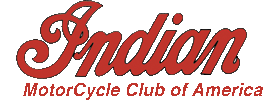
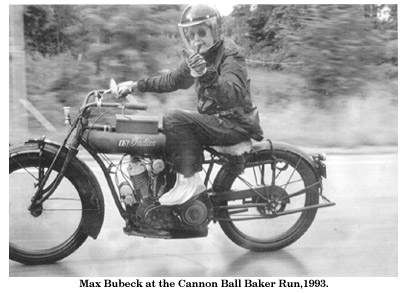

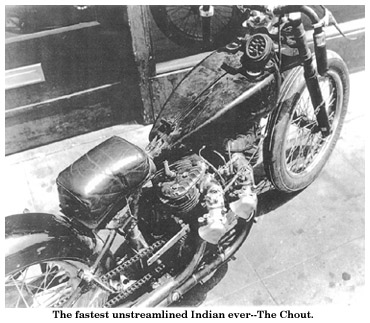
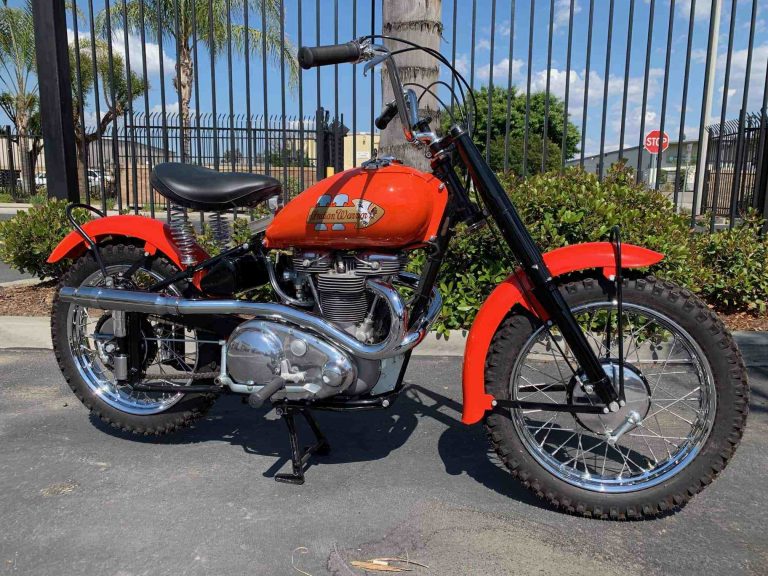

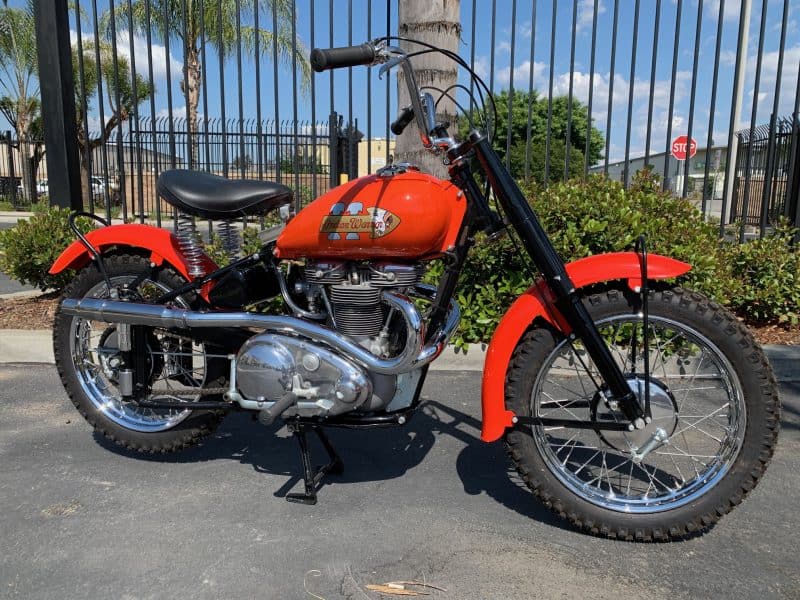
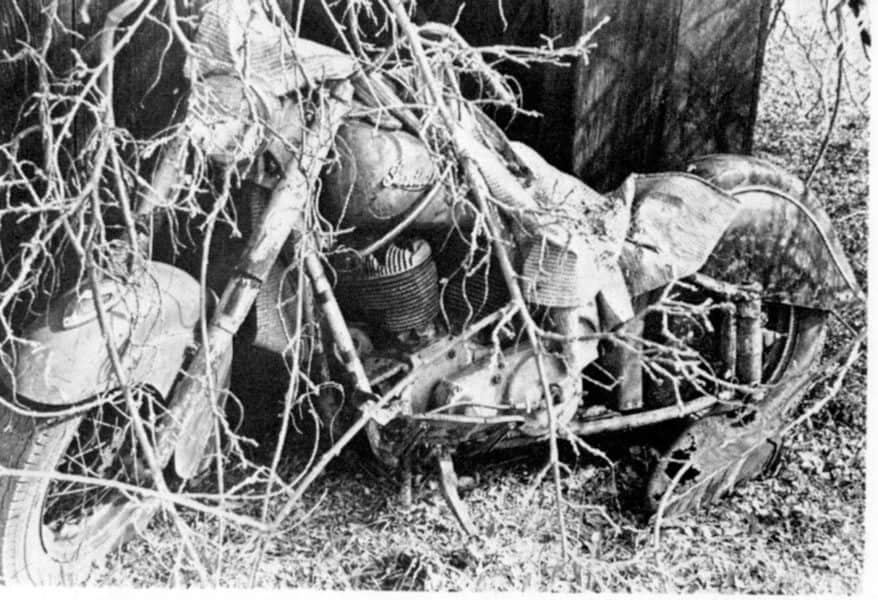
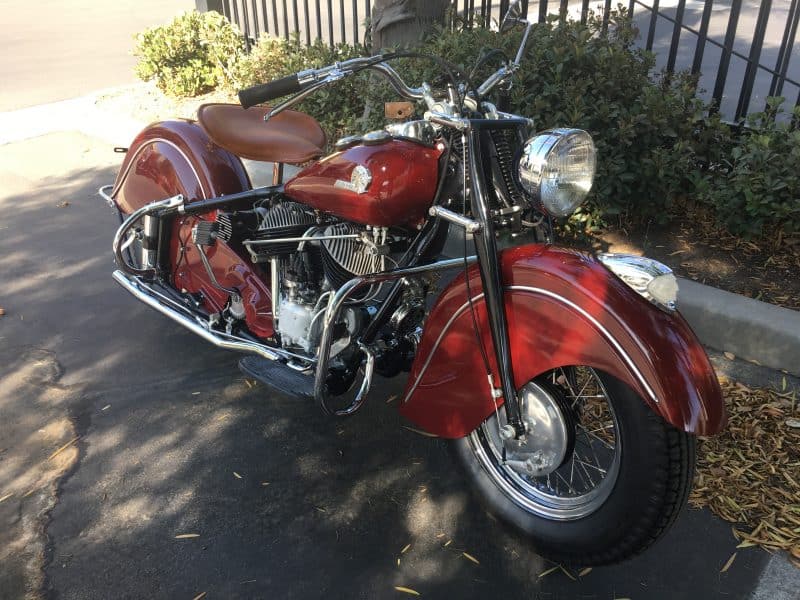














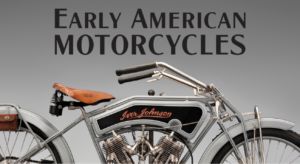 The
The 